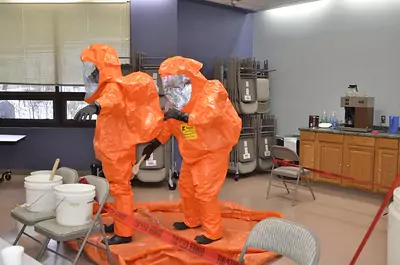Where Can You Get Free HAZWOPER Training? (5 Ways)
November 14, 2023 | by onlineoshasafetytraining.com


Free HAZWOPER training can be accessed from several sources, each offering different aspects of the training to meet various needs and requirements:
Read also: How to Get HAZWOPER Certified This Year
Accessing free HAZWOPER (Hazardous Waste Operations and Emergency Response) training can be a crucial step for professionals in the field of hazardous waste management and emergency response. Understanding the various avenues available for such training can help individuals enhance their skills and knowledge without incurring financial burdens.
One of the primary sources of free HAZWOPER training is through government-sponsored programs. These programs are often provided by federal or state agencies dedicated to workplace safety and environmental protection. They are designed to ensure that workers dealing with hazardous materials are well-prepared for the challenges they face. The eligibility for these programs may vary depending on the specific criteria set by the offering agency, and interested individuals can usually apply through the agency’s website or through their employer.
In the digital age, online educational platforms have become a significant resource for free training. Numerous websites and educational platforms offer HAZWOPER training courses at no cost. These courses often provide flexibility in terms of learning pace and schedule, making them a convenient option for many. However, it’s essential to assess the effectiveness and accreditation of these courses to ensure they meet the industry standards and OSHA requirements.
Non-profit organizations and charities also play a vital role in providing free HAZWOPER training. These organizations often focus on enhancing workplace safety and environmental protection and thus offer training to individuals who are either working in or aspiring to join the field of hazardous waste management. Funding for these programs typically comes from donations, grants, or government support, and enrollment processes may vary from one organization to another.
Another avenue for free training is through volunteer programs. Some organizations offer training in exchange for a commitment to volunteer for a certain period. This arrangement not only provides free training but also offers hands-on experience, which is invaluable in this field. Volunteering can be a rewarding way to gain practical skills while contributing to important environmental and safety efforts.
Lastly, scholarships and grants are an underutilized resource that can provide free HAZWOPER training. These financial aids are often available through educational institutions, industry associations, or even some employers. They are typically aimed at individuals pursuing careers in environmental safety and hazardous waste management. Finding these opportunities might require some research, but they can significantly reduce the financial barrier to receiving high-quality training.
| Training Source | Pros | Cons |
|---|---|---|
| Government-Sponsored Programs |
– Often meet OSHA standards. – Comprehensive and industry-focused. – Reliable and accredited. |
– May have strict eligibility criteria. – Limited availability depending on location. |
| Online Educational Platforms |
– Flexible and accessible anytime, anywhere. – Wide range of courses. – Often updated content. |
– Quality varies; some may not meet industry standards. – Less hands-on experience. |
| Non-Profit Organizations |
– Focus on practical skills. – Opportunities for networking. – Often funded by reputable sources. |
– Limited spots; competitive to get in. – Training scope may vary depending on the organization. |
| Volunteer Programs |
– Real-world experience. – Enhance resume with practical skills. – Networking opportunities. |
– Requires time commitment. – Training might be secondary to volunteering duties. |
| Scholarships and Grants |
– Financial support for comprehensive training. – Access to high-quality programs. |
– Requires application and often competitive. – May have specific requirements or conditions attached. |
While HAZWOPER training is crucial for professionals in hazardous waste operations and emergency response, it doesn’t always have to be a financial burden. Exploring government-sponsored programs, online courses, non-profit training, volunteer opportunities, and scholarships can provide valuable training for free or at a reduced cost. It’s important to consider the credibility and accreditation of these training programs to ensure they meet professional standards and regulatory requirements.
Read related article: Easy Way to Check HAZWOPER Certification
What to Expect in HAZWOPER Training
When considering HAZWOPER training, it’s important to understand what to expect in terms of course structure, content, and how these programs compare to their paid counterparts, along with any limitations or constraints.
- Typical Course Structure and Content:
- Course Structure: The training typically follows a structured format, which may include online modules, video lectures, interactive simulations, and quizzes. The training is often self-paced, allowing learners to progress through the modules as per their schedule.
- Content: Key topics usually covered include the recognition and identification of hazardous materials, safety and health hazards associated with hazardous waste operations, emergency response procedures, personal protective equipment (PPE), decontamination methods, and legal regulations such as OSHA standards under 29 CFR 1910.120.
- Certification Requirements: The training may include the 24-hour or 40-hour courses required for certification, depending on the individual’s role and exposure to hazardous waste sites.
- Comparison with Paid Training Programs:
- Quality and Depth: While free HAZWOPER training provides essential knowledge and meets basic regulatory requirements, paid programs may offer more in-depth analysis, hands-on experience, and access to industry experts.
- Resources and Support: Paid training might include additional resources like advanced simulations, in-person workshops, and direct support from trainers or industry professionals.
- Networking Opportunities: Paid programs often provide networking opportunities with professionals in the field, which can be beneficial for career advancement.
- Limitations or Constraints:
- Scope of Training: Courses may cover fundamental aspects but might not delve deeply into specialized topics or provide advanced training scenarios.
- Customization and Specificity: These courses are generally more generic and less tailored to specific industries or job roles compared to some paid programs.
- Accreditation and Recognition: While most training programs meet basic OSHA requirements, they may not always be recognized or accredited by all industry bodies or employers.
- Ongoing Support and Updates: Courses may not offer the same level of ongoing support, updates, or refresher modules that paid courses do, which can be crucial in an ever-evolving field like hazardous waste management.
Understanding these aspects can help individuals and organizations set the right expectations and choose the most suitable training option based on their specific needs and resources.
Read also: Does HAZWOPER Certification Expire? (Get Refreshed Now)
How to Apply for the Free HAZWOPER Training
Applying for this training involves a series of steps designed to ensure you find and successfully enroll in a course that suits your needs. Here’s a more detailed and comprehensive guide:
Detailed Steps to Apply for Free Training
- Conduct Thorough Online Research:
- Use search engines to look for “free HAZWOPER training.”
- Explore various websites, including government sites like OSHA, FEMA, and EPA, as they may have links to free training resources.
- Check online educational platforms and forums for recommendations on quality courses.
- Identify the Appropriate Training Course:
- Determine the type of training you need. There are different levels, such as 24-hour or 40-hour courses, depending on your job requirements or personal interest.
- Read course descriptions carefully to understand what each course offers, the duration, and whether it meets the regulatory requirements for the type of certification you need.
- Evaluate the Course Provider’s Credentials:
- Investigate the credentials of the organization or institution offering the training. Ensure they are reputable and recognized in the field of hazardous waste operations and emergency response.
- Look for reviews or testimonials from past participants to gauge the quality of the training.
- Register or Sign Up for the Chosen Course:
- Complete the registration process, which may involve creating an account on the course provider’s website.
- Fill out any required forms or surveys. Some programs might ask for basic information about your background or reasons for taking the course.
- Comply with Any Prerequisites or Requirements:
- Some courses might have prerequisites or require you to have certain equipment, like a computer with internet access.
- Ensure you meet these requirements before you start the course.
- Participate Actively in the Course:
- Follow the course schedule and participate in all the activities, including lectures, interactive sessions, and practical exercises.
- Engage with any online forums or discussion groups if available, as this can enhance your learning experience.
- Complete Assessments or Examinations:
- If the course has assessments, quizzes, or a final exam, ensure you complete them to demonstrate your understanding of the material.
- Some courses may require you to score a certain percentage on these assessments to receive a certificate of completion.
- Obtain Certification (if available):
- After successfully completing the course, download or request your certificate of completion.
- Check if the certificate explicitly states the hours of training and that it complies with OSHA standards.
- Stay Updated with Refresher Courses:
- The training may require periodic refreshers. Keep a record of when you might need to retake the course or a shorter refresher version to stay compliant.
Is the Free Training The Same Quality as the Paid?
| Aspect | Paid Training | Free Training |
|---|---|---|
| Comprehensiveness of Content | Covers a broader range of topics in greater depth, including advanced areas. | Covers essential topics; may not delve deeply into some subjects. |
| Instructional Quality | Often provided by experienced professionals with real-world insights. | Varies in expertise; less personal interaction and hands-on instruction. |
| Resources and Materials | Includes a wide array of materials and technological tools. | More limited resources and supplementary materials. |
| Networking and Support | Includes networking opportunities, ongoing support, and access to alumni networks. | May lack extensive networking opportunities; minimal ongoing support. |
| Certification and Recognition | Widely recognized with certified credentials upon completion. | Meets basic OSHA requirements; may lack the same industry recognition. |
| Customization and Flexibility | Offers tailored courses with flexible learning pace and style. | A one-size-fits-all approach with limited flexibility in course structure. |
Read related article: Which HAZWOPER Training Do You Need? (Different Levels)
Is the Online Hazwoper Training Being Recognized
Yes, online training can be recognized and valid, provided it meets the standards set by the Occupational Safety and Health Administration (OSHA). When considering an online training course, it’s important to ensure that it adheres to the following criteria for recognition:
- Compliance with OSHA Standards: The most crucial aspect is that the training adheres to OSHA’s regulations, particularly the requirements outlined in OSHA standard 29 CFR 1910.120. This standard specifies the training requirements for hazardous waste operations and emergency response.
- Certification Upon Completion: A recognized course should offer a certificate upon completion that indicates the number of training hours and the specific training level. This certification is often necessary for employment or regulatory compliance purposes.
- Quality of Instruction: The course should be conducted by qualified instructors who have expertise in hazardous waste operations and safety training. Even in an online format, the quality of instruction should not be compromised.
- Course Content: Ensure that the course content covers all necessary topics required for the training, such as safety and health procedures, personal protective equipment, hazardous material recognition, and emergency response.
- Hands-On Training Component: OSHA requires a hands-on component for HAZWOPER training. In an online setting, this might be challenging, so look for courses that offer simulations or partnerships with local facilities for practical experience.
- Accreditation or Approval: While not always mandatory, courses that are accredited or have some form of official approval may carry more weight and be more readily recognized by employers.
- Course Reviews and Reputation: Research the course’s reputation and read reviews from previous participants. Courses with positive feedback and good reputations are more likely to be recognized.
It’s important to note that while the core training can be completed online, certain aspects of the training, especially those involving hands-on experience with hazardous materials, might be more effective in a traditional in-person format. Always verify the credentials and recognition of any online training program before enrolling to ensure it meets the necessary criteria for your professional and safety requirements.
Read related article: Is In-Person Hazwoper Training Right for You? (Its Benefits)
Does It Cover all the Expenses
Free HAZWOPER training typically covers the cost of the training itself, meaning you won’t have to pay for the course content, instruction, and basic materials provided as part of the online or in-person training program. However, there are other potential expenses that might not be covered by the training, which you should be aware of:
- Equipment and Supplies: If the training requires specific equipment, such as safety gear or certain tools for hands-on practice, these are usually not included in the training and must be provided by the participant or their employer.
- Internet and Technology Costs: For online training programs, you’ll need a reliable internet connection and a suitable device (like a computer or tablet). These technology-related costs are typically your responsibility.
- Certification Fees: While the training might be without charge, some programs might charge a fee for issuing a formal certificate upon completion.
- Travel and Accommodation: If the training is offered in-person and is not local to you, you might incur travel and accommodation expenses.
- Time Investment: While not a direct financial cost, it’s important to consider the time you need to invest in completing the training, especially if it’s extensive like a 40-hour course. This time commitment can have indirect financial implications, particularly if you are taking time off work.
- Refresher Courses: This training requires regular refreshers (annually for most certifications). Whether these refreshers are free or not will depend on the provider, so future training costs should be considered.
While the training course itself might be given at no cost, there are additional expenses and considerations that you may need to account for when planning to undertake the training.
Read related article: How to Choose the Best HAZWOPER Training Programs?
How to Save Money From The Training
Saving money on HAZWOPER training requires strategic planning and exploration of various cost-effective options. Here are some key strategies:
- Research Free Training Opportunities
- Look for government or non-profit initiatives offering free training.
- Explore volunteer organizations or internships that provide free training as a part of their program.
- Utilize Employer Resources
- Inquire if your employer offers sponsored training, as many companies cover the cost for their employees.
- Propose a group training session at your workplace, which can be more cost-effective than individual training.
- Seek Educational Grants and Scholarships
- Apply for scholarships or educational grants aimed at occupational health and safety training.
- Check with local community colleges or vocational schools for available financial aid options.
- Choose Online Training Courses
- Opt for online training courses which are generally less expensive than in-person training.
- Compare different online platforms to find the most cost-effective yet accredited option.
- Leverage Early Bird and Group Discounts
- Register for training courses in advance to take advantage of early bird discounts.
- Organize a group of colleagues or peers to enroll together and negotiate for a group discount.
- Attend Community College or Vocational School Programs
- Some community colleges and vocational schools offer affordable training as part of their curriculum.
- Look into state-funded educational institutions for subsidized training programs.
- Negotiate Payment Plans
- If upfront payment is challenging, inquire if the training provider offers a payment plan to spread the cost over time.
- Some providers may offer deferred payment options or installment plans.
- Utilize Tax Deductions and Company Reimbursements
- Investigate if training expenses are tax-deductible as educational or professional development expenses.
- Check if your employer offers tuition reimbursement programs for career-related education.
- Monitor Promotions and Seasonal Offers
- Keep an eye out for promotional discounts or seasonal offers on training courses.
- Follow training providers on social media or subscribe to their newsletters for updates on special deals.
- Evaluate Return on Investment
- Consider the long-term benefits of HAZWOPER training, such as higher pay, better job opportunities, and enhanced safety skills.
- Weigh the initial cost against the potential increase in earning capacity and job security.
By exploring these strategies, individuals and organizations can significantly reduce the financial burden of HAZWOPER training while still acquiring essential skills and certifications.
Conclusion
Free HAZWOPER training is a great way for people to learn about handling hazardous waste and dealing with emergencies without having to pay for it. These courses cover the basic things that OSHA says are important, but they might not go into as much detail as courses that cost money.
Having this kind of training is really helpful, especially for people who work for smaller companies or who are on their own and can’t afford expensive courses. It makes it easier for more people to learn how to be safe when working with dangerous materials, which is good for everyone.
When picking a HAZWOPER course, it’s important to make sure the course has all the right information and follows the rules. People should also try to really get into the course and use what they learn in real life. They can also look for more information and talk to others in the same field.
RELATED POSTS
View all


